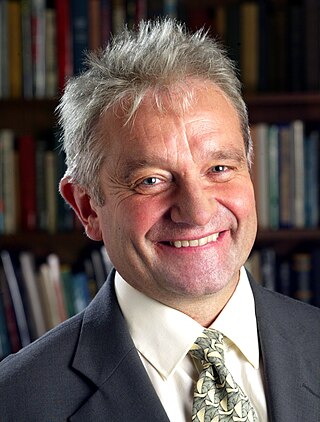Related Research Articles
Leland Harrison (Lee) Hartwell is former president and director of the Fred Hutchinson Cancer Research Center in Seattle, Washington. He shared the 2001 Nobel Prize in Physiology or Medicine with Paul Nurse and Tim Hunt, for their discoveries of protein molecules that control the division (duplication) of cells.

Cyclin-dependent kinases (CDKs) are a predominant group of serine/threonine protein kinases involved in the regulation of the cell cycle and its progression, ensuring the integrity and functionality of cellular machinery. These regulatory enzymes play a crucial role in the regulation of eukaryotic cell cycle and transcription, as well as DNA repair, metabolism, and epigenetic regulation, in response to several extracellular and intracellular signals. They are present in all known eukaryotes, and their regulatory function in the cell cycle has been evolutionarily conserved. The catalytic activities of CDKs are regulated by interactions with CDK inhibitors (CKIs) and regulatory subunits known as cyclins. Cyclins have no enzymatic activity themselves, but they become active once they bind to CDKs. Without cyclin, CDK is less active than in the cyclin-CDK heterodimer complex. CDKs phosphorylate proteins on serine (S) or threonine (T) residues. The specificity of CDKs for their substrates is defined by the S/T-P-X-K/R sequence, where S/T is the phosphorylation site, P is proline, X is any amino acid, and the sequence ends with lysine (K) or arginine (R). This motif ensures CDKs accurately target and modify proteins, crucial for regulating cell cycle and other functions. Deregulation of the CDK activity is linked to various pathologies, including cancer, neurodegenerative diseases, and stroke.

Sir Paul Maxime Nurse is an English geneticist, former President of the Royal Society and Chief Executive and Director of the Francis Crick Institute. He was awarded the 2001 Nobel Prize in Physiology or Medicine, along with Leland Hartwell and Tim Hunt, for their discoveries of protein molecules that control the division of cells in the cell cycle.

Kim Ashley Nasmyth is an English geneticist, the Whitley Professor of Biochemistry at the University of Oxford, a Fellow of Trinity College, Oxford, former scientific director of the Research Institute of Molecular Pathology (IMP), and former head of the Department of Biochemistry, University of Oxford. He is best known for his work on the segregation of chromosomes during cell division.
Cdc25 is a dual-specificity phosphatase first isolated from the yeast Schizosaccharomyces pombe as a cell cycle defective mutant. As with other cell cycle proteins or genes such as Cdc2 and Cdc4, the "cdc" in its name refers to "cell division cycle". Dual-specificity phosphatases are considered a sub-class of protein tyrosine phosphatases. By removing inhibitory phosphate residues from target cyclin-dependent kinases (Cdks), Cdc25 proteins control entry into and progression through various phases of the cell cycle, including mitosis and S ("Synthesis") phase.

Cell cycle checkpoints are control mechanisms in the eukaryotic cell cycle which ensure its proper progression. Each checkpoint serves as a potential termination point along the cell cycle, during which the conditions of the cell are assessed, with progression through the various phases of the cell cycle occurring only when favorable conditions are met. There are many checkpoints in the cell cycle, but the three major ones are: the G1 checkpoint, also known as the Start or restriction checkpoint or Major Checkpoint; the G2/M checkpoint; and the metaphase-to-anaphase transition, also known as the spindle checkpoint. Progression through these checkpoints is largely determined by the activation of cyclin-dependent kinases by regulatory protein subunits called cyclins, different forms of which are produced at each stage of the cell cycle to control the specific events that occur therein.

The Cancer Research UK London Research Institute (LRI) was a biological research facility which conducted research into the basic biology of cancer.
Aisling Maria Burnand was a British business executive and consultant. In 2009, she joined Cancer Research UK as Executive Director of Policy & Public Affairs. In 2014, she became chief executive of the Association of Medical Research Charities.

Cyclin-dependent kinase 1 also known as CDK1 or cell division cycle protein 2 homolog is a highly conserved protein that functions as a serine/threonine protein kinase, and is a key player in cell cycle regulation. It has been highly studied in the budding yeast S. cerevisiae, and the fission yeast S. pombe, where it is encoded by genes cdc28 and cdc2, respectively. With its cyclin partners, Cdk1 forms complexes that phosphorylate a variety of target substrates ; phosphorylation of these proteins leads to cell cycle progression.

Wee1 is a nuclear kinase belonging to the Ser/Thr family of protein kinases in the fission yeast Schizosaccharomyces pombe. Wee1 has a molecular mass of 96 kDa and is a key regulator of cell cycle progression. It influences cell size by inhibiting the entry into mitosis, through inhibiting Cdk1. Wee1 has homologues in many other organisms, including mammals.

Angelika Amon was an Austrian American molecular and cell biologist, and the Kathleen and Curtis Marble Professor in Cancer Research at the Massachusetts Institute of Technology (MIT) in Cambridge, Massachusetts, United States. Amon's research centered on how chromosomes are regulated, duplicated, and partitioned in the cell cycle. Amon was elected to the American Academy of Arts and Sciences in 2017.

The G2-M DNA damage checkpoint is an important cell cycle checkpoint in eukaryotic organisms that ensures that cells don't initiate mitosis until damaged or incompletely replicated DNA is sufficiently repaired. Cells with a defective G2-M checkpoint will undergo apoptosis or death after cell division if they enter the M phase before repairing their DNA. The defining biochemical feature of this checkpoint is the activation of M-phase cyclin-CDK complexes, which phosphorylate proteins that promote spindle assembly and bring the cell to metaphase.
Doreen Ann CantrellCBE, FRS, FRSE, FMedSci is a British scientist and Professor of Cellular Immunology at the School of Life Sciences, University of Dundee. She researches the development and activation T lymphocytes, which are key to the understanding the immune response.
Zoi Lygerou is a Greek molecular biologist and associate professor at Patras Medical School. Lygerou's works have been published in such journals as the European Journal of Biochemistry, Journal of Cell Science, the Molecular and Cellular Biology journal, Journal of Biological Chemistry, and both Science and Nature journals among others. She is especially known for her work on cell cycle control mechanisms in eukaryotic organisms, and has done research at the University of Patras since 1999. Lygerou has also held positions at the European Molecular Biology Laboratory (EMBL) and at the Imperial Cancer Research Fund in London under Paul Nurse.

Sir Stephen Philip Jackson, FRS, FMedSci is the Frederick James Quick Professor of Biology. He is a senior group leader at the Cancer Research UK Cambridge Institute and associate group leader at the Gurdon Institute, University of Cambridge.

Wendy Anne Bickmore is a British genome biologist known for her research on the organisation of genomic material in cells.
Irene May Leigh CBE FRSE FMedSci is a British dermatologist. A former professor of Barts and The London School of Medicine and Dentistry, she is now a professor emeritus at the University of Dundee School of Medicine. Her research has focused on keratinocytes, non-melanoma skin cancers and genetic skin diseases. She was elected to the Academy of Medical Sciences in 1999 and appointed CBE in 2012.

(Robert) Charles Swanton is British physician scientist specialising in oncology and cancer research. Swanton is a senior group leader at London's Francis Crick Institute, Royal Society Napier Professor in Cancer and thoracic medical oncologist at University College London and University College London Hospitals, co-director of the Cancer Research UK (CRUK) Lung Cancer Centre of Excellence, and Chief Clinician of Cancer Research UK.
Julian Blow is a molecular biologist, Professor of Chromosome Maintenance, and also the Dean of the School of Life Sciences, University of Dundee, Scotland.
Melanie Jane Davies, is a British physician and academic, who specialises in type 2 diabetes mellitus. Since 2007, she has been Professor of Diabetes Medicine at the University of Leicester. She is the director of the National Institute for Health Research (NIHR) Leicester Biomedical Research Centre.
References
- 1 2 "Notice of Annual General Meeting". Lundbeck. 1 March 2012. Archived from the original on 6 December 2017. Retrieved 14 September 2015.
- 1 2 Weston, Kathleen. "6: Divide and Rule". Blue Skies and Bench Space. Cancer Research UK. Retrieved 14 September 2015.
- ↑ "Honour for University of York plant biologist". University of York. 2 January 2009. Retrieved 14 September 2015.
- 1 2 3 4 Cahoon, Lauren (26 September 2008). "From Watching 'The Expert' to Becoming An Expert". Science Magazine. doi:10.1126/science.caredit.a0800142 . Retrieved 14 September 2015.
- ↑ Nurse, Paul (2007). "The discovery of cdc2 as the key regulator of the cell cycle". Cells. Jones and Bartlett Publishers. Retrieved 14 September 2015.
- ↑ Smith, Jim (March 2009). "The cell cycle and beyond: an interview with Paul Nurse". Disease Models & Mechanisms. 2 (3–4): 113–5. doi:10.1242/dmm.002592. PMC 2650208 . PMID 19259383.
- ↑ Dr Melanie Lee CBE FMedSci, Academy of Medical Sciences. Retrieved 4 March 2014
- ↑ "LifeArc announces new CEO appointment". LifeArc. 4 September 2018. Retrieved 30 March 2019.
- ↑ "Melanie Lee". Life Science Integrates. Retrieved 14 May 2020.
- ↑ "Melanie G. Lee CBE, PhD, FMedSci, DSc (Hons)". BloombergBusiness. Retrieved 14 September 2015.
- ↑ "Dr Melanie Lee CBE FMedSci". The Academy of Medical Sciences. Retrieved 14 September 2015.
- ↑ "Melanie Lee becomes CEO of Syntaxin". MedNous. Evernow Publishing. 8 February 2010. Retrieved 14 September 2015.
- ↑ "About us". Think10. Retrieved 14 September 2015.
- ↑ "Dowling Review Group". Royal Academy of Engineering. Retrieved 14 September 2015.
- ↑ BIA. "Melanie Lee CBE | BIA Lifetime Achievement Award Winner 2019". www.bioindustry.org. Retrieved 30 March 2019.
- ↑ Dr. Melanie Lee, Chairman of CRT, is awarded Commander of the Order of the British Empire (CBE), Cancer Research Technology. Retrieved 4 March 2014
- ↑ "New Year honours list: DBEs and CBEs". The Guardian. 31 December 2008. Retrieved 14 September 2015.
- ↑ "The UK's 100 leading practising scientists". Times Higher Education. 17 January 2014. Retrieved 14 September 2015.